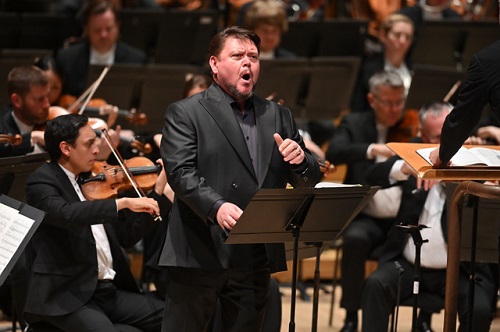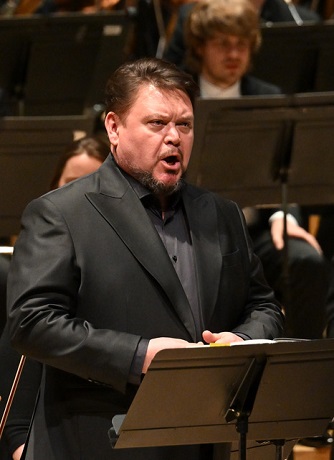Shostakovich’s ‘Babi Yar’ Symphony, his thirteenth, is amongst his greatest works – and yet in a sense it disappeared completely after its troubled premiere on December 18th, 1962. The composer initially wished Mravinsky to conduct the first performance but his refusal – certainly under political pressure, but also quite possibly on the grounds of antisemitism – led him to Kirill Kondrashin who faced his own problems: the cancellation of the bass soloist, Victor Nechipaylo, on the eve of the premiere and pressure to abandon the first movement entirely. A soloist, Vitaly Gromadsky, was found, and the performance went ahead with the first movement intact.
That sense of ‘disappearance’, of trying to eradicate all possible exposure given to the symphony’s premiere, stretched to no mention in the Soviet press the following day of its performance. Indeed, for over half a century the only known performance to exist of the symphony on recordings by Kondrashin and Gromadsky from December 1962 is the one given two days later; the premiere itself did not emerge until it was published (along with Kondrashin giving the premiere of the Fourth Symphony) on CDs issued by The Moscow Tchaikovsky Conservatory in 2015.
Kondrashin’s 1965 recording of the symphony did take into account the one concession that the Soviet authorities wanted before the first performance: that Yevgeny Yevtushenko’s first poem, Babi Yar, which he had been forced to rewrite, acknowledge that the 1941 massacre by the Nazis of Jews in what was then Soviet Ukraine not just imply it was an act of antisemitism but was also one about the suffering of Russians. When Kondrashin came to re-record the symphony with the Bavarian Radio Symphony Orchestra, he used Yevtushenko’s original text – a standard in the west, although it wouldn’t be until 1970 that it would be premiered there until Ormandy and the Philadelphia Orchestra played the work.

Although this symphony’s choral and soloist settings are relatively simple – and above all have a sense of remarkable clarity – it is unique in what it sounds like. The choice of a bass and a chorus of basses – with the choir singing in unison, with no complex counterpoint – layers this symphony with a particular kind of gravity: it is unequivocally Russian in colour, immersed in the music of Mussorgsky which Shostakovich had orchestrated during this period. Boris Godunov and his Songs and Dances of Death are like ghosts at the banquet; entirely present if invisible to most listeners.
Despite the massacre at Babi Yar, the Soviets erected no monument to it – principally because of the Jewish context. Shostakovich does this for them in music that comes to symbolise both the horror of the atrocity and the desolation that is left through State hypocrisy. Yevtushenko’s poem, in its original form, is graphic, and inspired Shostakovich to compose music to equal it: the tolling bell, which will occur throughout the symphony, the chilling motif on the woodwind, pizzicato as hard as bullets and later the gutted terror of the woodblock. If there was any doubt this is a symphony and not a cantata or just a choral work, moments of orchestral climax are gruesome, violent and terrifying. His use of timpani, and the tam-tam is just as catastrophic, just as elemental, as in the ‘Leningrad’ or Eighth Symphony. It’s crushing and devastating.
Humor – the title for the second movement – is in a sense sardonic, but it could also be Mahlerian in how Shostakovich treats it. The text is really anything but this: it speaks of vagrants and beggars, of executions and heads on soldiers’ pikes, of political prisoners and humour locked in dungeons. The bells strike again. The symphony’s last three movements – beginning with In the Stores, the marvellously descriptive horror of Russia’s mothers in threadbare shawls queuing for food – are played without a pause – and here we get one of Shostakovich’s most chilling effects in his entire symphonic output, the repeated hollow tapping rhythm on a woodblock. It winds between cellos and basses of terrifying depth, as cavernous as the grim terrain of the ravine, or they sound hobbled with the coarseness of the tuba. The bell intervenes throughout, and there are the threads of horror on the tam-tam and bass drum knitted together. The final movement introduces us to its fugue – sung by the bass – and Shostakovich takes us back to Babi Yar, where we began, before ending in silence – unsettled, though it is, on the tolling bell which fades into nothing like a final breath.
Performances of the symphony are not commonplace these days – its overwhelming power, despair and terror can make it a suffocating piece for audiences. But, it is also problematic for performers who need to maintain a level of intensity throughout a symphony that is rarely going to be less than an hour in length.
Gianandrea Noseda’s performance of it with the London Symphony Orchestra, recorded as part of his ongoing Shostakovich cycle, certainly packed a punch, even if it is not going to challenge any of the performances given by the symphony’s first conductor, Kondrashin. The Thirteenth has, by and large, largely employed either a Russian or Soviet-born bass (increasingly, we will see basses from its former satellites singing this part, of course). The one notable exception was Kondrashin’s final live recording, from 1980 and performed on the same December date as the work’s premiere, in Munich which had John Shirley-Quirk as the bass – and this is, ironically, one of the greatest recordings ever made of the symphony.
Noseda had the Ukrainian bass Vitalij Kowaljow, one of the better choices we are going to have on record. He projected both power and richness, precisely what the work needs from the soloist. Both might actually be slightly lacking with the work’s first singer, Gromadsky, but what makes a great performance is the ability to subjectivize the emotions the symphony asks for. The bass doesn’t particularly work with the chorus, who are more narrators of the events in Yevtushenko’s texts; rather he is there to give the opposite point of view.
It was easy to be persuaded by the sheer beauty and brilliance of Kowaljow’s singing – his control was impeccable, one rarely needed to turn to the text so clear was his diction, he never sounded pressured or undersized against the orchestra or the chorus when singing in unison with them. What seemed lacking was a clarity of thinking, a reading of Yevtushenko which seemed in any sense remarkable. If the orchestra was partly evoking terror in one thing (such as during the Dreyfus episode), Kowaljow rarely followed. We might have got a more graphic, a more heart-rending picture of hardship in In the Stores than the one that he conjured up. I don’t think enough of a picture emerged in the fourth movement – Fear felt less bleak than it might have.

The combined male tenors and basses of the London Symphony Chorus and London Philharmonic Choir felt a little muddied, although how much this is a problem with the Barbican rather than with the performance itself might be better resolved on the recording. There was little to quibble with here musically: tonally, the sound was gorgeous, although perhaps too mellow, lacking just that gruff-dark Russianness which makes old Soviet recordings so compelling.
Which brings us to the LSO. British orchestras, like Japanese ones, have long played Russian music with a convincing sense of near authenticity: it sounds close to being right, but they’re missing the crudeness. The Thirteenth, more than most of Shostakovich’s symphonies, although somewhat in common with his later ones, largely eschews that latter Russian trait; in part, this is why western orchestras are less of an issue in this work. Noseda did get terrific playing from the LSO – you really couldn’t have asked for richer, darker strings than we got here. He also managed to get menacing, exciting playing from the percussion and timpani – the repeated woodblock was grotesquely done, although I did sometimes wish that the tolling bell had more iron to it; it sometimes felt cautious. Climaxes were torrential, like a hurricane tearing through the orchestra, such as in the ominous terror we got towards the close of the first movement. Noseda magnificently had the orchestra build up to a shattering crescendo in Fears – only for them to plunge into a full string pianissimo of astounding, almost stagnant near-silence. Some of the woodwind playing was ravishing, almost decadently so – it almost felt anathematic. The final movement’s opening flute duet, for example, was shredded of all pain and darkness. He seemed to take the close of the symphony – where it moves into interminable silence – as if each instrument were like a page being torn from a book until nothing but the binding was left. It was where the performance reached its greatest impact, but in a sense rather too late.
It will be fascinating to revisit this performance when the recording emerges but this didn’t strike me as a Babi Yar that will rival the best.
The opening work was Beethoven’s ‘Emperor’ Concerto played by the Macedonian pianist Simon Trpčeski. I found this performance troubling – largely because I have rarely, if ever, come across a soloist on stage who has seemed to me to display such a lack of concentration whilst playing; in part, I do not entirely lay all of the blame on him. It didn’t entirely affect all of the Beethoven we got; but it didn’t help, and we might have got a better interpretation of it.
Granted, the audience were quite intrusive – but a far worse example happened just the previous week during a violinist’s performance of the slow movement of Khachaturian’s Violin Concerto and he remained entirely focused on his performance (even though the conductor was clearly beyond irritated).
There were, however, moments of fine playing in the Beethoven. Notably, a rather fine introduction to the second movement where the clarity of playing and diamond-like sharpness of tone took us away from the rather usual ornamental expression we often hear. It was certainly refreshing – as was some of the crystalline finger work in the third movement. But generally, this wasn’t a performance I’m keen to dwell on – I’ve heard Trpčeski play much better, as well as seen audiences treat their pianists better.
Marc Bridle
Beethoven – Piano Concerto No.5, ‘Emperor’; Shostakovich – Symphony No.13, ‘Babi Yar’
Simon Trpčeski (piano), Vitalij Kowaljow (bass), tenors and basses of London Symphony Chorus and London Philharmonic Choir, Aidan Oliver (chorus master), London Symphony Orchestra, Gianandrea Noseda (conductor)
Barbican Hall, London; Sunday 2nd April 2023.